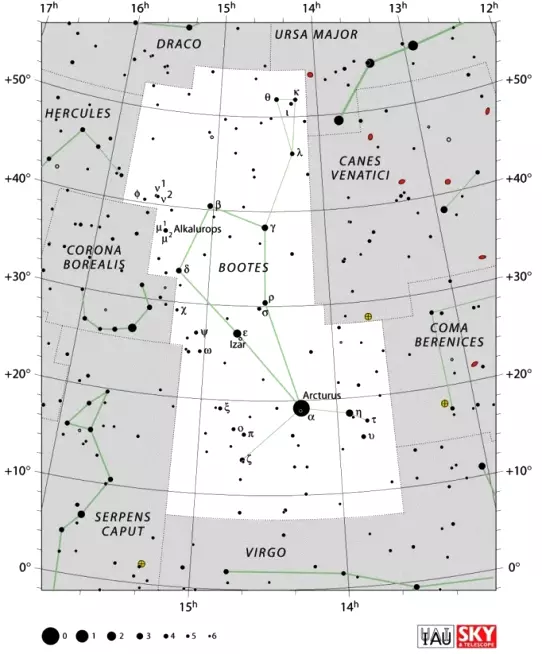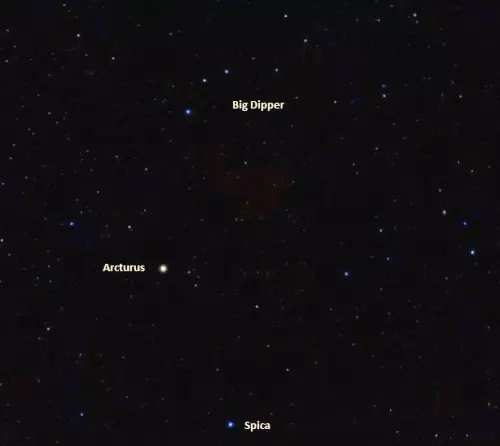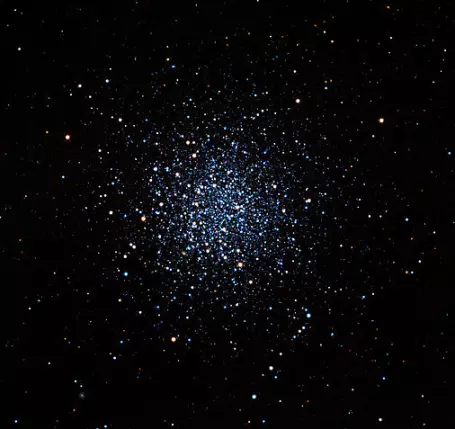Boötes is one of the largest constellations in the sky. Located in the northern celestial hemisphere, the constellation is dominated by the Kite, a diamond-shaped asterism formed by its brightest stars.
The constellation’s name comes from the Greek word Βοώτης, Boōtēs, which means ox driver, plowman, or herdsman. The correct pronunciation is /boʊˈoʊtɨs/, with each ‘o’ pronounced separately and stress on the second syllable. Boötes was first catalogued by the Greek astronomer Ptolemy in the 2nd century.
The constellation is home to the contrasting double star Izar and Arcturus, the brightest star in the northern celestial hemisphere and third individual brightest star in the sky, after Sirius in Canis Major and Canopus in Carina constellation.
Facts, location and map
Boötes is the 13th largest constellation in the night sky, occupying an area of 907 square degrees of the northern sky. It is located in the third quadrant of the northern hemisphere (NQ3).The entire constellation is visible from locations between the latitudes +90° and -50°. The neighboring constellations are Canes Venatici, Coma Berenices, Corona Borealis, Draco, Hercules, Serpens Caput, Virgo, and Ursa Major.
The constellation name Boötes is pronounced /boʊˈoʊtiːz/. In English, the constellation is known as the Herdsman. The genitive form of Boötes, used in star names, is Boötis (pronunciation: /boʊˈoʊtɪs/). The three-letter abbreviation, adopted by the International Astronomical Union (IAU) in 1922, is Boo.
Boötes belongs to the Ursa Major family of constellations, along with Camelopardalis, Canes Venatici, Coma Berenices, Corona Borealis, Draco, Leo Minor, Lynx, Ursa Major, and Ursa Minor.
The brightest star in the constellation is Arcturus (Alpha Boötis). With an apparent magnitude of -0.05, the red giant is the brightest star in the northern celestial hemisphere and the fourth brightest star in the sky, after Sirius, Canopus and Alpha Centauri.
The nearest star in Boötes is Gliese 526 (Wolf 498, Lalande 25372), a red dwarf located 17.726 light-years away.
The celestial Herdsman contains 10 stars with known planets. The orange subgiant HD 141399 is home to a planetary system consisting of at least four massive gas giants. The K-type dwarf HN Boötis (HD 128311) has two confirmed planets and a third unconfirmed candidate.
Other stars with extrasolar planets include the yellow-white main sequence stars Tau Boötis and WASP-14, the yellow giants Nikawiy (HD 136418) and 24 Boötis, the orange subgiant Arcalís (HD 131496), the yellow dwarfs HD 132406 and HAT-P-4, and the yellow-white giant HD 132563.
The constellation Boötes contains 11 named stars. The star names approved by the International Astronomical Union (IAU) are Alkalurops (Mu1 Boötis), Arcalís (HD 131496), Arcturus (Alpha Boötis), Izar (Epsilon Boötis A), Merga (38 Boötis), Muphrid (Eta Boötis A), Nekkar (Beta Boötis), Nikawiy (HD 136418), Quadrans (44 Boötis A), Seginus (Gamma Boötis Aa), and Xuange (Lambda Boötis).
Boötes does not contain any Messier objects. There are three meteor showers associated with the constellation: the January Bootids, the June Bootids, and the Quadrantids.
The best time of the year to observe Boötes is during the month of June, when the constellation appears higher in the sky around 9 pm.

Boötes constellation map by IAU and Sky&Telescope magazine (Roger Sinnott & Rick Fienberg) (CC BY 3.0)
Myth
Boötes is traditionally depicted as a herdsman with two hunting dogs on a leash and a club in his other hand. In the sky, Boötes follows Ursa Major around the pole. In one story, the constellation represents a ploughman driving the oxen in the Ursa Major constellation, followed by his two dogs, Asterion and Chara (represented by the constellation Canes Venatici, the Hunting Dogs). The ploughman’s oxen are tied to the polar axis and their movement keeps the skies in constant rotation
Most commonly, Boötes is taken to represent Arcas, son of Zeus and Callisto, daughter of the Arcadian king Lycaon. Arcas was brought up by his grandfather, the king, who one day decided to test Zeus by serving him his own son for a meal.
Zeus, however, saw through Lycaon’s intentions, transformed the cruel king into a wolf, struck down all his sons with thunderbolts, and brought Arcas back to life.
Zeus’ wife Hera, having heard of her husband’s disloyalty, transformed Callisto into a bear. Callisto roamed the woods until years later she met her son, who was now grown up. Arcas didn’t recognize his mother and began to chase her. Callisto hid herself in a temple, where he could not hurt her without risking being convicted for defiling a sacred place. To avoid a tragedy, Zeus placed both of them in the sky; Callisto as Ursa Major and Arcas as Boötes.
In another story, Boötes is taken to represent Icarius, a grape grower who once invited Dionysus to visit his vineyards. The god was so impressed that he gave Icarius the secret of making wine. Icarius followed the recipe and enjoyed the beverage so much that he invited all his friends to try it. However, they had never tried wine before and, when they woke up the next day not feeling well, they assumed Icarius had tried to poison them. Angry, they did away with him while he slept. Dionysus was saddened by the passing of his friend and decided to place Icarius among the stars. In another myth, Boötes is credited for inventing the plough, which prompted the goddess Ceres to place him in the heavens.
Boötes stars
Arcturus – α Boötis (Alpha Boötis)
Arcturus is the third brightest star in the sky and the brightest star in the northern hemisphere. It has an apparent magnitude of -0.04. It is often listed as the fourth brightest star, behind Alpha Centauri, because the latter is a binary star with a combined magnitude of -0.27.
Arcturus, however, is the third individual brightest star in the night sky, followed by Rigil Kentaurus (Alpha Centauri A), the brightest star in Centaurus and the fourth individual brightest star in the sky.
The name Arcturus means “guardian of the bear” in Ancient Greek. The star is located at the left foot of the Herdsman, the one standing next to the bear constellations, Ursa Major and Ursa Minor.
Alpha Boötis is a type K1.5 IIIpe orange giant, one with an unusual spectrum of light and full of emission lines. (The “pe” stands for “peculiar emission.”) Approximately 36.7 light years distant, the star has a luminosity at least 110 times that of the Sun and a very high proper motion; it moves at 122km/s relative to the solar system. It will arrive at the point nearest to the Sun in approximately 4,000 years.

Arcturus location, image: Wikisky
Arcturus can easily be found if one follows the arc of the three bright stars that form the handle of the Big Dipper asterism in Ursa Major.
It is a member of the Local Interstellar Cloud (or Local Fluff), an interstellar cloud through which the Earth and the solar system are currently moving. The cloud is 30 light years across.
Arcturus is believed to be an old disk star. It appears to be travelling with a group of 52 other old disk stars, commonly known as the Arcturus moving group.
Nekkar – β Boötis (Beta Boötis)
Nekkar is a yellow G-type giant 219 light years from Earth. It is a flare star, a type of variable star that shows dramatic increases in luminosity for a few minutes. The name Nekkar derives from a mis-transliteration of the Arabic word for “cattle driver.” Sometimes the star is also referred to as Meres.
Seginus – γ Boötis (Gamma Boötis)
Seginus is a Delta Scuti type variable star, one showing variations in brightness as a result of both radial and non-radial pulsations on its surface. The star is approximately 85 light years distant. Its luminosity varies between magnitude 3.02 and 3.07 with a period of 6.97 hours. The star belongs to the spectral class A7III.
Izar (Pulcherrima) – ε Boötis (Epsilon Boötis)
Izar is a binary star located approximately 300 light years away in the constellation Boötes. It consists of a bright orange giant and a smaller and fainter main sequence star.
Epsilon Boötis is also sometimes known as Pulcherrima, which means “the loveliest” in Latin. The name Izar comes from the Arabic word for “veil.” The star’s other traditional names are Mirak (“the loins” in Arabic) and Mizar.
Muphrid – η Boötis (Eta Boötis)
Eta Boötis is a spectroscopic binary star with a period of 494 days. It is located close to Arcturus in the sky, only 3.24 light years away. The star’s traditional name is Muphrid, derived from the Arabic phrase for “the single one of the lancer.” It is also known as Saak.
Muphrid lies 37 light years from Earth. It belongs to the spectral class G0 IV. It has a significant excess of elements heavier than hydrogen.
Alkalurops – μ Boötis (Mu Boötis)
Mu Boötis is also known as Alkalurops. The name comes from the Greek word kalaurops, which means “the shepherd’s staff.”
Alkalurops is a triple star approximately 121 light years distant. The brightest component is a yellow-white F-type subgiant with an apparent magnitude of 4.31. The companion is a binary star lying 108 arc seconds away.
Merga – h Boötis (38 Boötis)
Merga lies about 153 light years from Earth and belongs to the spectral class F7IVw. The name Merga comes from the Arabic phrase meaning “the chained woman.” The star has an apparent magnitude of 5.74.
Nadlat – ψ Boötis (Psi Boötis)
Psi Boötis, or Nadlat, is an orange K-type giant 250 light years distant. It has an apparent magnitude of 4.52.
τ Boötis (Tau Boötis)
Tau Boötis is another binary star in Boötes, approximately 51 light years from Earth. It consists of a yellow-white dwarf and a dim red dwarf. The primary star has an extrasolar planet in its orbit, discovered in 1996 and confirmed in 1999.
Deep sky objects in Boötes
Boötes void
The Boötes void, also known as the Great Void or the Supervoid, is a sphere-shaped region of the sky, almost 250 million light years in diameter, which contains very few galaxies. Its approximate location is at right ascension 14h 20m and declination 26°. The void was originally discovered by Robert P. Kirshner, Harvard College Professor of Astronomy, in 1981, as part of a survey of galactic redshifts. By now, it is known that there are at least 60 galaxies in the void. American astronomer Gregory Scott Alderling once observed, “If the Milky Way had been in the center of the Boötes void, we wouldn’t have known there were other galaxies until the 1960s.”
Boötes I (Boötes Dwarf Galaxy)
The Boötes Dwarf Galaxy is a dwarf spheroidal galaxy located approximately 197,000 light years from Earth. It is one of the faintest galaxies known, with an absolute magnitude of -5.8 and apparent magnitude of 13.1. It was only discovered in 2006.
Boötes I orbits the Milky Way Galaxy and, because of its distorted shape, it is believed to be tidally disrupted by the Milky Way. The galaxy is approximately 720 light years across.
NGC 5466
NGC 5466 is a globular cluster approximately 51,800 light years from Earth. The cluster was first discovered by the German-born British astronomer William Herschel in 1784. It lies about 52,800 light years from the Galactic centre.
The cluster is notable because it contains a blue horizontal branch of stars and is as metal poor as regular globular clusters.

NGC 5466 in the constellation Boötes, image: Wikimedia Commons/Jschulman555 (CC BY-SA 3.0)